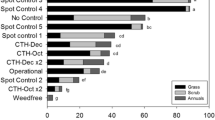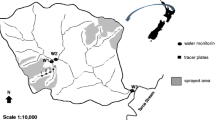Abstract
Background, aim, and scope
Large-scale deforestation is occurring in subarctic North America following clearing by salvage logging or insect attack. Numerous shrubs, herbs, and deciduous tree species tend to dominate areas on which stands of white spruce have grown. In the absence of economically advantageous mechanical methods, several herbicides have value in efforts to reforest by planting white spruce. Glyphosate, imazapyr, triclopyr, and hexazinone are all capable of selectively removing many competing species, but there is concern about whether they would degrade naturally or persist owing to the frigid climate.
Materials and methods
We established test plots with all four herbicides in upland and river bottom sites at 65°N and 58°N latitudes. The northern site has extremely cold winters, with soils that freeze to a depth of 1–2 m, and precipitation of 275 mm/year. The southern site has heavy rain and snowfall, amounting to 2,250 mm/year evenly distributed. Soil seldom freezes deeply. On each test plot, one of the four herbicides was applied at twice the normal operational use rate to facilitate detection. They were applied at the normal timing, with hexazinone, imazapyr, and triclopyr applied in June and glyphosate applied in fall. Soils were sampled immediately after treatment and those samples used as references for dissipation data gathered over the next 11–14 months from soil 0- to 15- and 15- to 45-cm depths.
Results
Dissipation rates did not follow first-order rates because freezing conditions slowed most microbial activity. All products dissipated to close to or below detection limits within the time of the study. Dissipation from vegetation was substantially more rapid and depended on the nature of the plants treated as well as the product used. While soil residues dissipated more slowly than in temperate regions, they did display consistent dissipation patterns during above-freezing conditions and also the influence of microbial activity. Mobility was very limited with all products but hexazinone.
Discussion
These products dissipate during summer in high latitudes much as they would in temperate climates. Winter changes are small, but are not unlike some changes reported elsewhere under freezing conditions. Unlike many other studies, soil water did not influence dissipation heavily, but the high latitude and semi-arid climate also did not create severely droughty soils. Residues in plants were much higher than those in soils, but denatured the vegetation quickly, leading to unsuitability for forage in any case.
Conclusions
Low toxicity of these products and their metabolites combined with consistent dissipation and low mobility suggest that toxic hazard of their use at high latitudes need not be a matter of serious concern to humans, terrestrial wildlife, or aquatic systems. They are safe for use in management and rehabilitation of boreal forests when used properly.
Recommendations and perspectives
Dissipation at rates approaching those in warmer climates offer a hypothesis that microflora native to high latitudes may be adapted to destruction of such molecules at lower temperatures than may be indicated by experiments with microflora adapted to warmer climates. Residues pose no observable risk to wildlife or humans in the area of use when products are applied properly.


Similar content being viewed by others
References
Ahrens WH (1994) Herbicide handbook, 7th edn. Weed Science Society of America, Champaign, IL
Benoit P, Barriuso E, Calvet R (1998) Biosorption characterization of herbicides, 2,4-D and atrazine, and two chlorophenols on fungal mycelium. Chemosphere 37:1271–1282
Benoit P, Madrigal I, Preston CM, Chenu C, Barriuso E (2008) Sorption and desorption of non-ionic herbicides onto particulate organic matter from surface soils under different land uses. Eur J Soil Sci 59:178–189
Cessma AJ, Waddington J (1995) Dissipation of glyphosate and its metabolite AMPA in established crested wheatgrass following spring application. Can J Plant Sci 75:759–762
Choi JS, Fermanian TW, Wehner DJ, Spomer LA (1988) Effect of temperature, moisture, and soil texture on DCPA degradation. Agron J 80:108–113
Cole EC, Newton M (1997) Competition and the need for vegetation management. In: Reforestation and Vegetation in Central Alaska. State and Private Forestry Special Report R-10-TP-65. USDA Forest Service, Anchorage, AK, pp I-1–I-19
Cole EC, Newton M, Youngblood A (1999) Regenerating white spruce, paper birch, and willow in south-central Alaska. Can J For Res 29:993–1001
Fahnestock J, Jones MH, Welker JM (1999) Wintertime CO2 efflux from arctic soils: implications for annual carbon budgets. Glob Biogeochem Cycles 13:775–779
Feng JC, Navratil S (1990) Sampling for zero-time hexazinone residues in forest soil dissipation study. Can J For Res 20:1549–1552
Feng JC, Thompson DJ (1990) Fate of glyphosate in a Canadian forest watershed. 2. Persistence in foliage and soils. J Agric Food Chem 38:1118–1125
Helbert S (1990) Behaviour of four soil-active herbicides in a boreal podzol. For Ecol Manage 31:125–152
Jarvis NJ, Almqvist S, Stenstrom J, Borjesson E, Jonsson E, Gorstensson L (2006) Modelling the leaching of imazapyr in a railway embankment. Pest Manag Sci 62:940–946
Johnson WG, Lavy TL, Gbur ED (1995) Sorption, mobility, and degradation of triclopyr and 2,4-D on four soils. Weed Sci. 43(4):678–684
Jotcham JR, Smith DW, Stephenson GR (1989) Comparative persistence and mobility of pyridine and phenoxy herbicides in soil. Weed Technol 3:155–161
Lautenschlager RA, Gjerstad DH, Glover GR, Mitchell RJ, Horsley SB, Zedaker SM, Dougherty PM (eds) (1992) Response of wildlife to forest herbicide applications in northern coniferous ecosystems. Proceedings of the International Conference on Forest Vegetation Management. Can J For Res 23:2286–2299
Leveille P, Legris L, Couture J (1996) Residus d’hexazinone dans le sol après une pulverization terreste en milieu forestier. Gouvernement du Quebec, Ministere des Resources Naturelles, 19 pp
Lieffers VJ, Macdonald SE, Hogg EH (1993) Ecology and control strategies for Calamagrostis canadensis in boreal forest sites. CJFR 23:2070–2077
Lipson DA, Monson RK (1998) Plant-microbe competition for soil amino acids in the alpine tundra: effects of freeze-thaw and dry-rewet events. Oecologia 113:406–414
Manning MJ (1994) Analytical method for glyphosate and AMPA in raw agricultural commodities and their processed fractions. Document No. RES-008-90, Version No. 4. Monsanto, St. Louis, MO
Meyer AF, Lipson DA, Martin AP, Schadt CW, Schmidt SK (2004) Molecular and metabolic characterization of cold tolerant Pseudomonas senso stricto. Appl Environ Microbiol 70:483–489
Michael JL, Neary DG (1993) Herbicide dissipation studies in southern forest ecosystems. Environ Toxicol Chem 12:405–410
Mohn WW, Westerberg K, Cullen WR, Reimer J (1997) Aerobic biodegradation of biphenyl and polychlorinated biphenyls by Arctic soil microorganisms. Appl Environ Microbiol 63:3378–3384
Monsanto Co. (1991) Analytical method for glyphosate and AMPA in soil. Document No. ES-014-91, Version No. 0. Monsanto, St. Louis, MO
Neary DG, Bush PB, Michael JL (1993) Fate, dissipation and environmental effects of pesticides in southern forests: a review of a decade of research progress. Environ Toxicol Chem 12:411–428
Newton M, Cole EC (1997) Reforestation and vegetation in central Alaska. Special Report R10-TP-65. Forest Health Protection. USDA Forest Service. Alaska Region, 74 pp
Newton M, Howard KM, Kelpsas BR, Danhaus R, Lottman CM, Dubelman S (1984) Fate of glyphosate in an Oregon forest ecosystem. J Agric Food Chem 32:1144–1151
Newton M, Roberts F, Allen A, Kelpsas B, White D, Boyd P (1990) Deposition and dissipation of three herbicides in foliage, litter, and soil of brushfields in southwest Oregon. J Agric Food Chem 38:574–583
Parker LW, Doxtader KG (1982) Kinetics of microbial decomposition of 2,4-D in soil: effects of herbicide concentration. J Environ Qual 11(4):679–684
Parker LW, Doxtader KG (1983) Kinetics of the microbial degradation of 2,4-D in soil: effects of temperature and moisture. J Environ Qual 12(4):553–558
Pignatello JJ, Ferrandino FJ, Huang LQ (1993) Elution of aged and freshly added herbicides from a soil. Environ Sci Technol 27:1563–1571
Schmiel JP, Bilbroough C, Welker JM (2004) Increased snow depth affects microbial activity and nitrogen mineralization in two arctic tundra communities. Soil Biol Biochem 36:217–227
Steinberg SM, Pignatello JJ, Sawhney BL (1987) Persistence of 1,2-dibromomethane in soils: entrapment in intraparticle micropores. Environ Sci Technol 21:1201–1208
Steinmetz JR (1994) Analytical method for glyphosate and AMPA in raw agricultural commodities and their processed fractions. Document RES-008-90, Version 4. Monsanto, St. Louis, MO
Stenrod M, Eklo OM, Charnay MP, Benoit P (2005) Effect of freezing and thawing on microbial activity and glyphosate degradation in two Norwegian soils. Pest Manag Sci 61:887–898
Stephenson GR, Solomon KR, Bowlby CS, Liber K (1990) Persistence, leachability, and lateral movement of triclopyr (Garlon) in selected Canadian forest soils. J Agric Food Chem 38:584–588
Stougaard RN, Shea PJ, Martin AR (1990) Effect of soil type and pH on adsorption, mobility, and efficacy of imazaquin and imazethapyr. Weed Sci 38:67–73
Thompson DG, Cowell JE, Daniels RJ, Staznik B, MacDonald LM (1989) Liquid chromatographic method for quantitation of glyphosate and metabolite residues in organic and mineral soils, stream sediments, and hardwood foliage. J Assoc Off Anal Chem 72:355–360
Thompson DG, Pitt DG, Buscarini TM, Staznik B, Thomas DR, Kettela E (1994) Initial deposits and persistence of forest herbicide residues in sugar maple (Acer saccharum) foliage. Can J For Res 24:2251–2262
Thompson DG, Pitt DG, Buscarini TM, Staznik B, Thomas DR (2000) Comparative fate of glyphosate and triclopyr herbicides in the forest floor and mineral soil of an Acadian forest regeneration site. Can J For 30:1808–1816
Torstensson L, Borjesson E (2004) Use of imazapyr against Equisetum arvense on Swedish railway tracks. Pest Management Science 60:565–569
Torstensson L, Borjesson E, Stenstrom J (2005) Efficacy and fate of glyphosate on Swedish railway embankments. Pest Manag Sci 61:881–886
Acknowledgments
Guidance in organization of the research was provided by Logan A. Norris, Oregon State University Department of Forest Science, and Ian J. Tinsley, Department of Environmental and Molecular Toxicology, Oregon State University. Gene Johnson, Department of Environmental and Molecular Toxicology, provided substantial assistance in analysis of residues. Brian Roth, presently with the Department of Forestry, University of Florida, Gainesville, provided substantial assistance in the field conduct of the experiments in Alaska. Ed Holsten and Ken Zogas, USDA Forest Service Div. of State and Private Forestry, Anchorage, AK, provided both personal and administrative support for this project. Funding for the project was provided by the US Department of Agriculture, National Agricultural Pesticide Impact Assessment Program. R. A. Werner, USDA Forest Service, Institute of Northern Forestry, Fairbanks, AK, provided administrative support. Dr. Ted Alby, of BASF Inc. (then American Cyanamid Co.), Vancouver WA, provided QA support.
Author information
Authors and Affiliations
Corresponding author
Additional information
Responsible editor: Alvin L. Young
Electronic Supplementary Material
Below is the link to the electronic supplementary material.
ESM
(PDF 94.0 KB)
Rights and permissions
About this article
Cite this article
Newton, M., Cole, E.C. & Tinsley, I.J. Dissipation of four forest-use herbicides at high latitudes. Environ Sci Pollut Res 15, 573–583 (2008). https://doi.org/10.1007/s11356-008-0039-7
Received:
Accepted:
Published:
Issue Date:
DOI: https://doi.org/10.1007/s11356-008-0039-7




